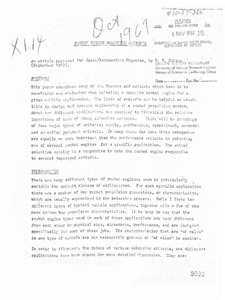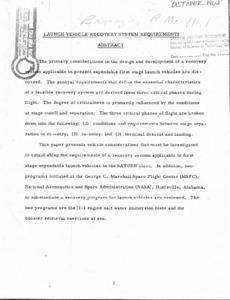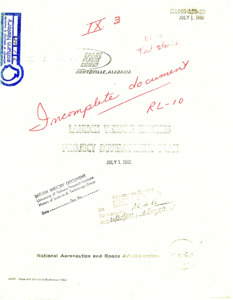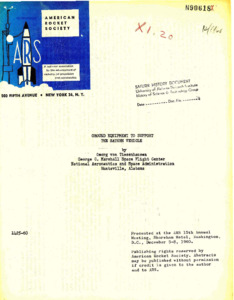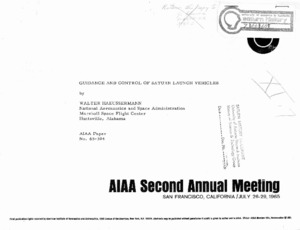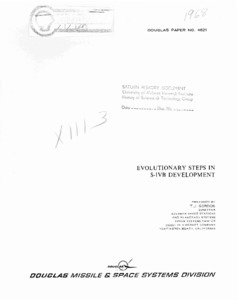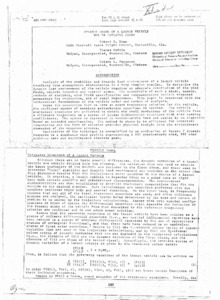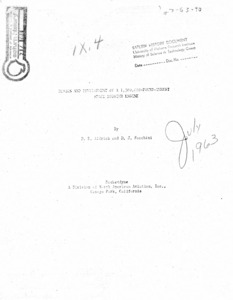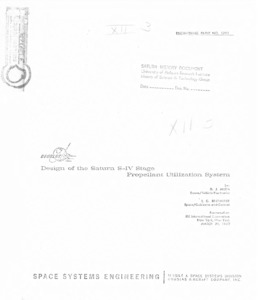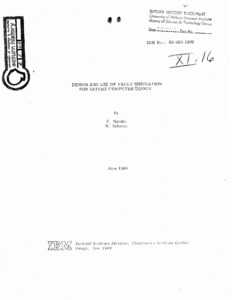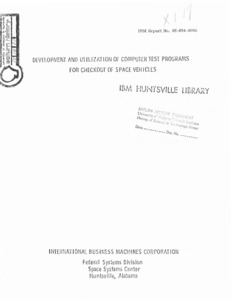
Browse Items (11 total)
Sort by:
-
"Rocket engine selection criteria."
This paper considers many of the factors and criteria which have to be considered and evaluated when selecting a specific rocket engine for a given vehicle application. The lists of criteria can be helpful as checklists in design and systems engineering of a rocket propulsion device. About ten different applications are examined to illustrate the relative importance of some of these selection criteria. There will be groupings of our major types of criteria; namely, performance, operational, economic and so-called judgment criteria. In many cases the last three categories are equally or more important than the performance criteria in selecting one of several rocket engines for a specific application. The actual selection usually is a compromise to make the rocket engine responsive to several important criteria. -
"Launch Vehicle Recovery System Requirements."
The primary considerations in the design and development of a recovery system applicable to present expendable first stage launch vehicles are discussed. The general requirements that define the essential characteristics of a feasible recovery system are derived from three critical phases during flight. The degree of criticalness is primarily influenced by the conditions at stage cutoff and separation. The three critical phses of flight are broken down into the following: (1) conditions and requirements between stage separation to re-entry; (2) re-entry; and (3) terminal descent and landing. -
"Launch Vehicle Engines Project Development Plan."
The primary mission objective of the 5-2 Engine Project is to continue development of a liquid oxygen/liquid hydrogen engine. capable of high-altitude restart. Both Saturn IB and Saturn V vehicles will use the J-2 engine; the S-IVB stage of Saturn IB vehicles and S-IVB stage of Saturn V vehicles will be equipped with a single J-2 engine. The S-I1 stage of Saturn V vehicles will use a cluster of five J-2 engines. Figure 1-3 illustrates these stages. -
"Ground Equipment to Support the Saturn Vehicle."
With the advent of the first large space vehicle, the SATURN, the ground support equipment and launch facility designer is faced with the necessity of conceiving and building an unprecedented launch system concurrent with the vehicle development. The paper intends to present a comprehensive picture of the problems involved and how they are solved. It follows the SATURN through the various modes of operation such as transportation over land and water, checkout, handling and erection, propellant loading, and describes the facilities at the launch site. -
"Guidance and Control of Saturn Launch Vehicles."
The navigation, guidance, and control modes and problems of the Saturn launch vehicles are given as the requirements for the guidance and control methods. Two path adaptive guidance modes, featuring flight path optimization, in the form of a polynomial mode and an iterative mode are given in their computation form and compared with respect to mission flexibility, implementation requirements, and performance. Attitude control during the propelled flight phases requires consideration of various bending and sloshing modes; stability of the control system is obtained by phase stabilization of the low frequencies and by attenuation of the higher frequencies. Typical shaping networks and their transfer functions are given. The attitude control system during coasting periods is briefly described. The functional behavior and characteristic data of the main guidance and control hardware such as the inertial sensors, stabilized platform, digital computer, data adapter, control computer, and actuation system are described. Reliability requirements are emphasized. The principle of redundancy is extensively used to obtain highest reliability for long operating times. Data and results from recent Saturn I flights summarize the performance of the guidance schemes. -
"Evolutionary Steps in S-IVB Development."
The injection stage of a multistage launch vehicle must be partially a velocity stage and partially a spacecraft; it must not only boost the payload, it must also perform cooperative mission operations with the payload after orbital insertion. These hybrid requirements result in intrinsic stage versatility which permits consideration of new and challenging missions for the stage which were unanticipated during initial design.; Prepared by T. J. Gordon, Director, Advance Space Stations and Planetary Systems, Space Systems Center, Douglas Aircraft Company, Huntington Beach, California. -
"Dynamic Loads of a Launch Vehicle Due to Inflight Winds."
Analysis of the stability and dynamic load environment of a launch vehicle resulting from atmospheric disturbances is a very complex problem. To determine the dynamic load environment of the vehicle requires an adequate description of the wind field, vehicle dynamics and control system. The essential of such a study, namely methods of analysis, wind field specification and representative vehicle response parameters for evaluation, are of equal importance. This paper is concerned with the mathematical foundations of the vehicle model and method of analysis. -
"Design and Development of a 1,500,000-Pound-Thrust Space Booster Engine."
Describes the F-1 engine design and components. -
"Design of the Saturn S-IV Stage Propellant Utilization System."
Describes the SIV vehicle and its components. Presented at: IRE International Convention. -
"Design and Use of Fault Simulation for Saturn Computer Design."
Describes different aspect of the Fault Simulation for Saturn computer design. -
"Development and Utilization of Computer and Test Programs for Checkout of Space Vehicles."
A computer system was designed to allow test engineers to progressively employ automation in the checkout of the Uprated Saturn I and Saturn V space vehicle programs and still allow manual control of the checkout process. A two-computer system was selected by National Aeronautics and Space Administration, and the International Business Machines Corporation was chosen to provide the programming engineering necessary to implement these objectives. Space vehicle checkout, prior to launch, may be characterized by controlling, monitoring, and testing the vehicle and its subsystems through the use of ground support equipment (GSE).; IBM Huntsville Library.; Presented at AIAA Conference, XVIIth International Astronautical Congress, Madrid, Spain, October 10-15, 1966 by Edward A. Robin, Manager, Vehicle Test Programming Department.
